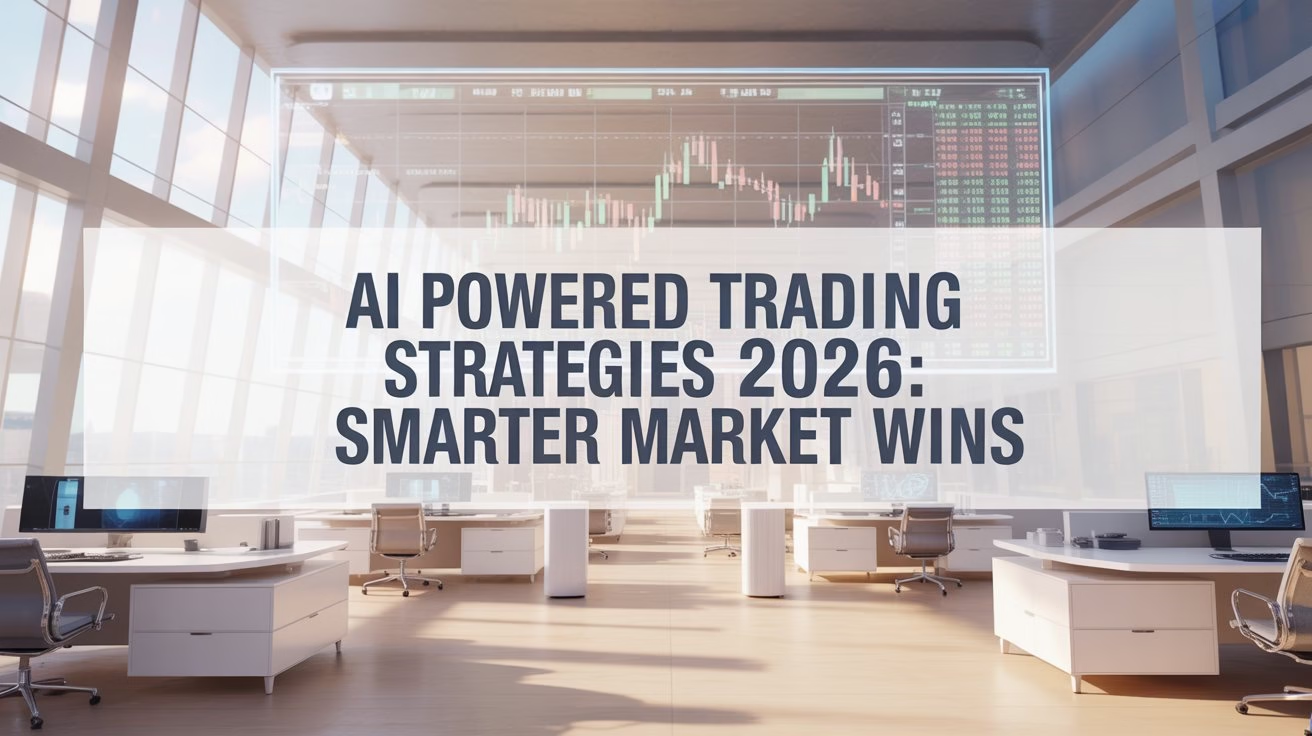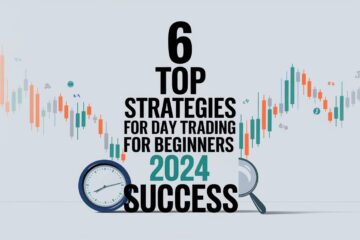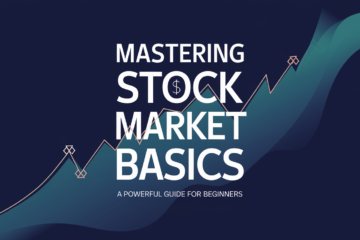Screens fill with charts, watchlists, and news banners all day. Somewhere between excitement and noise, a trader still has to decide whether to buy, sell, or wait. That pressure feels lighter when a smart system quietly filters data and highlights what genuinely deserves attention.
In 2026, AI-powered trading strategies 2026 turn that idea into something practical. The edge comes from combining clear rules, calm risk control, and AI that reads more data than any single person can manage, while still keeping you in charge of the final call.
What AI-Powered Trading Strategies 2026 Actually Mean

The phrase sounds futuristic, yet the structure stays straightforward. AI reads market data, finds repeatable patterns, and helps convert those patterns into rules that can be tested and followed with discipline. Human traders define goals and limits; the system handles volume and complexity.
Industry research from the CFA Institute shows that most firms use AI to enhance pattern detection and portfolio decisions rather than replace human oversight.
Regulators and researchers increasingly describe algorithmic and AI-based trading as tools that require strong controls, not magic formulas.
AI models digest price, volume, volatility, news, and sometimes sentiment to build a richer market picture than a single indicator can offer.
- Clear strategy rules translate that picture into conditions for trend entries, reversals, or flat “no trade” zones. This structure reduces random reactions.
- Backtests show how rules would have behaved across previous markets, which builds more grounded confidence than reacting to a single fresh signal.
- Once live, the same logic can flag when current conditions drift away from the patterns that originally supported the strategy.
How AI Reads Market Data Before Suggesting Any Trade

Before any signal appears, AI needs solid data. Good platforms begin with reliable price feeds, business events, and sometimes order-book or options information. Without that base, even advanced models create weak or misleading outputs.
Surveys on machine learning in trading highlight that data quality and feature design matter as much as the choice of model.
- Data pipelines clean and align ticks, candles, and corporate events, so models see consistent time-series instead of messy, incomplete feeds.
- Feature engineering turns raw numbers into momentum scores, volatility bands, correlation measures, and other context-rich variables.
- AI then learns which feature patterns tended to appear before favourable moves, neutral action, or sharp drawdowns. The goal is clarity, not complexity for its own sake.
- Monitoring dashboards track hit rates, drawdowns, and latency, giving you feedback on whether performance holds up outside the backtest.
A BIS working paper on AI for monitoring financial markets describes similar machine learning workflows for cleaning data, building features, and tracking behavior over time.
Core Styles of Machine Learning Trading Strategies
Different personalities need different trading styles. Machine learning usually strengthens ideas that already make logical sense, rather than inventing completely unfamiliar tricks.
That is why AI-powered trading strategies 2026 often cluster around familiar buckets that traders already recognise from manual approaches.
- Trend-following strategies use AI to confirm when strength deserves attention. Models read direction, volume, and volatility to filter out weak or choppy breakouts.
- Mean-reversion setups rely on detecting stretched moves. AI checks distance from typical ranges and highlights spots where prices historically snapped back.
- Statistical arbitrage baskets watch relationships across related instruments. Machine learning helps estimate fair value spreads and flag temporary deviations worth trading.
- Event-driven logic reacts to earnings, macro data, or sector news. AI measures how similar events played out before and suggests entries when fresh headlines match those earlier patterns.
Landscape of AI Trading Tools 2026 You Will See
New tools appear constantly, yet good ones share common traits: clear interfaces, strong controls, and honest documentation. Articles on top algorithmic and AI trading tools 2026 often mention scanners, backtesting environments, and automation layers that serve both retail and professional users.
For your own stack, the aim is to choose a combination that feels understandable and sustainable.
- Some platforms focus on scanning charts and building watchlists, leaving execution entirely in your hands. This suits traders who want AI as a research assistant.
- Others offer strategy-building studios where you design rules visually or with simple conditions, then let the system run them across live markets.
- A few tools specialise in particular asset classes like crypto or derivatives, with data and analytics tuned to those instruments.
- Compliance-focused platforms highlight audit trails, throttles, and guardrails, aligning with the regulatory emphasis on safe algorithmic trading.
Top 5 AI Trading Tools to Explore in 2026
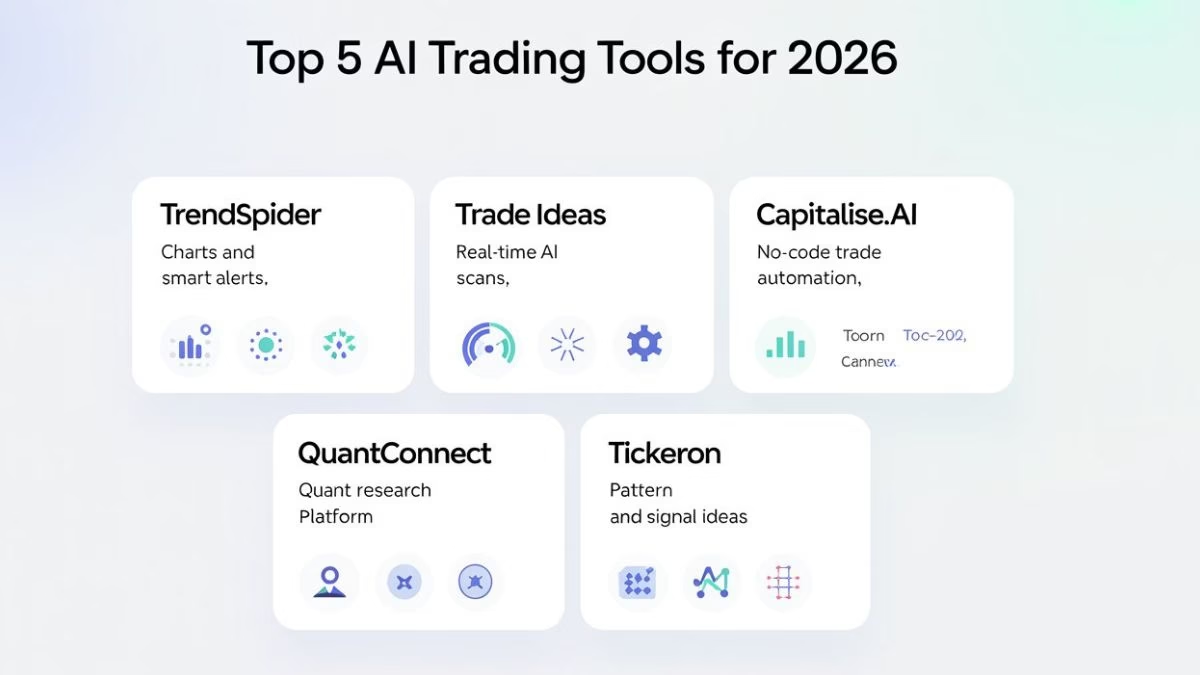
With so many choices, a simple shortlist helps. This section focuses on five widely discussed tools that support scanning, backtesting, or automation without demanding a PhD in coding. Use it as a map, then match each tool’s strengths to your own style.
- TrendSpider automates technical analysis, multi-timeframe scanning, and alerting. It draws levels, watches breakouts, and helps swing traders keep an eye on multiple charts without constant manual effort.
- Trade Ideas offers real-time stock scanning and an AI engine that suggests strategies with backtested stats. Many users like its clear performance reports and risk suggestions around each idea.
- Capitalise.ai lets you write rules in plain language, then turns them into live automations connected to supported brokers. This approach works well if you think in “if–then” sentences instead of code.
- QuantConnect targets more technical traders. It supports multiple assets, institutional-grade data, and cloud backtesting in languages such as C# and Python. It feels powerful if you enjoy deeper research.
- Tickeron leans toward pattern recognition and AI-assisted trade suggestions. It highlights chart formations, tests them against history, and presents probability-style stats for each pattern.
Choosing the Best AI Trading Platforms 2026 for Your Style
A platform that excites one trader may frustrate another. The best AI trading platforms 2026 match your time, temperament, and markets. External reviews and platform comparisons usually focus on ease of use, asset coverage, and risk tools. Each platform makes more sense when it fits real trading habits instead of only looking good in marketing screenshots.
While you explore options, it works well to treat platform selection as a risk decision, not only a convenience upgrade. Guidance from ESMA on algorithmic trading under MiFID II highlights the need for robust controls, pre-trade checks, and clear audit trails around automated systems.
In India, a recent SEBI circular on retail participation in algorithmic trading echoes similar themes around exchange approval, risk controls, and safe API use, which gives a helpful checklist for evaluating brokers and tools.
- Lifestyle questions come first. Day traders usually need fast dashboards, depth of market, and direct broker integration, while part-time traders may prefer cleaner evening scans and simple execution.
- Cost structure matters more than it seems at first glance. Some tools charge flat monthly fees, others bundle costs into spreads or commissions, so comparing total yearly cost against expected usage keeps expectations realistic.
- Safety features deserve as much attention as charts. Circuit breakers, throttles, and activity logs help you catch runaway behaviour early and keep you aligned with regulatory expectations.
- Regional support rounds things out. Platforms that understand local tax rules, reporting formats, and market hours make it easier to stay compliant while you focus on strategy and risk.
Risk Rules That Keep AI Trading Strategies Safe for Beginners
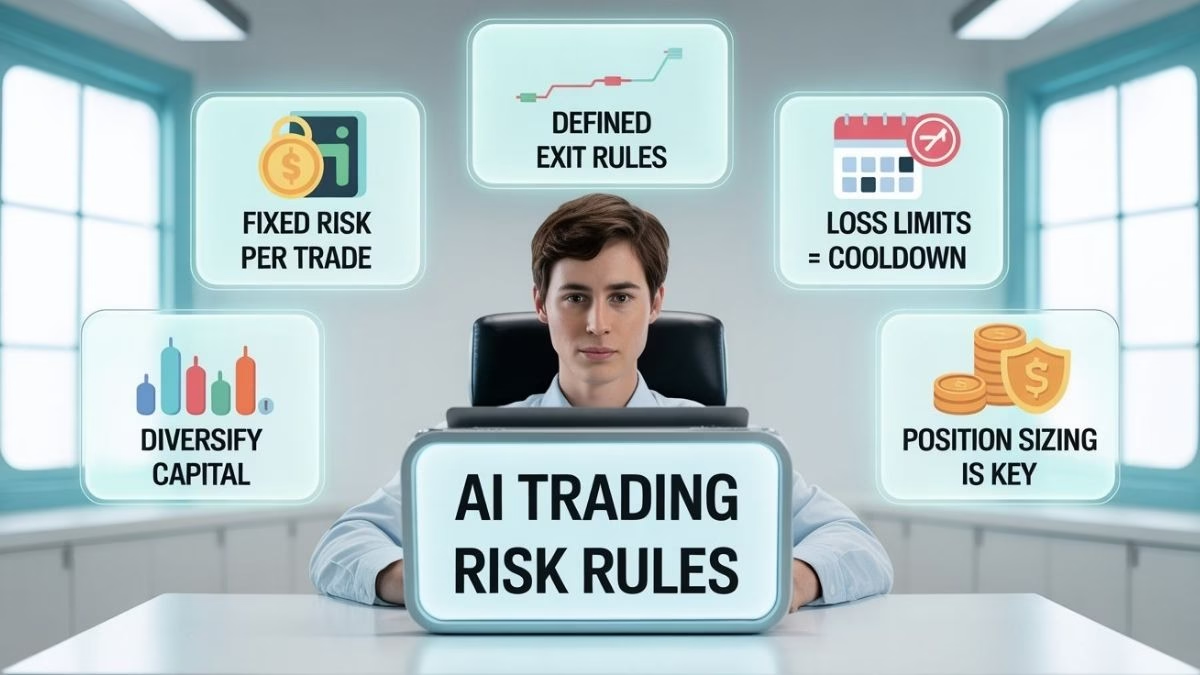
Beginners often feel tempted to hand everything to automation. However, safer AI trading strategies for beginners start with risk, then work backwards to signals. Position sizing, stop placement, and drawdown limits protect accounts when markets behave roughly.
High-quality guides from Investopedia, Britannica, and trading academies keep repeating one theme: position sizing remains central to risk management.
- Fixed percentage risk per trade caps how much damage a single loss can do. This builds resilience through both quiet and volatile periods. Guides like Investopedia – position sizing explain how turning risk into a fixed share of capital per trade helps protect the account when markets turn volatile.
- Clear exits for both profit and loss reduce emotional interference. AI can enforce those exits even when your mood tempts you to delay decisions.
- Daily or weekly loss limits force cooling-off breaks after tough stretches. Algorithms can stop new entries once those limits are triggered.
- Diversified approaches, where capital spreads across several instruments or styles, reduce dependence on one fragile pattern.
How AI Stock Market Analysis 2026 Feeds Better Decisions
Not every trader wants full automation. Many use AI stock market analysis 2026 mainly to understand conditions, stress test portfolios, and plan scenarios. Reports from behavioral and market research groups show rising interest in AI tools among retail investors worldwide.
A report from the Ontario Securities Commission on AI and retail investing shows how these tools already support diversification, risk checks, and decision support for everyday investors.
This analytical layer fits beautifully with thoughtful manual decision-making.
- Factor dashboards show which themes, such as quality or momentum, currently drive returns, helping you choose stocks that align with the dominant environment.
- Scenario engines simulate how portfolios might react to shifts in rates, growth expectations, or sector news, so you can adjust before stress peaks.
- Sentiment modules scan headlines and social posts to summarise tone, allowing you to measure mood instead of guessing.
- Correlation maps reveal hidden concentrations, such as multiple positions that all react to the same macro driver, even if they sit in different sectors.
Daily Workflow for a Human + AI Trading Partnership
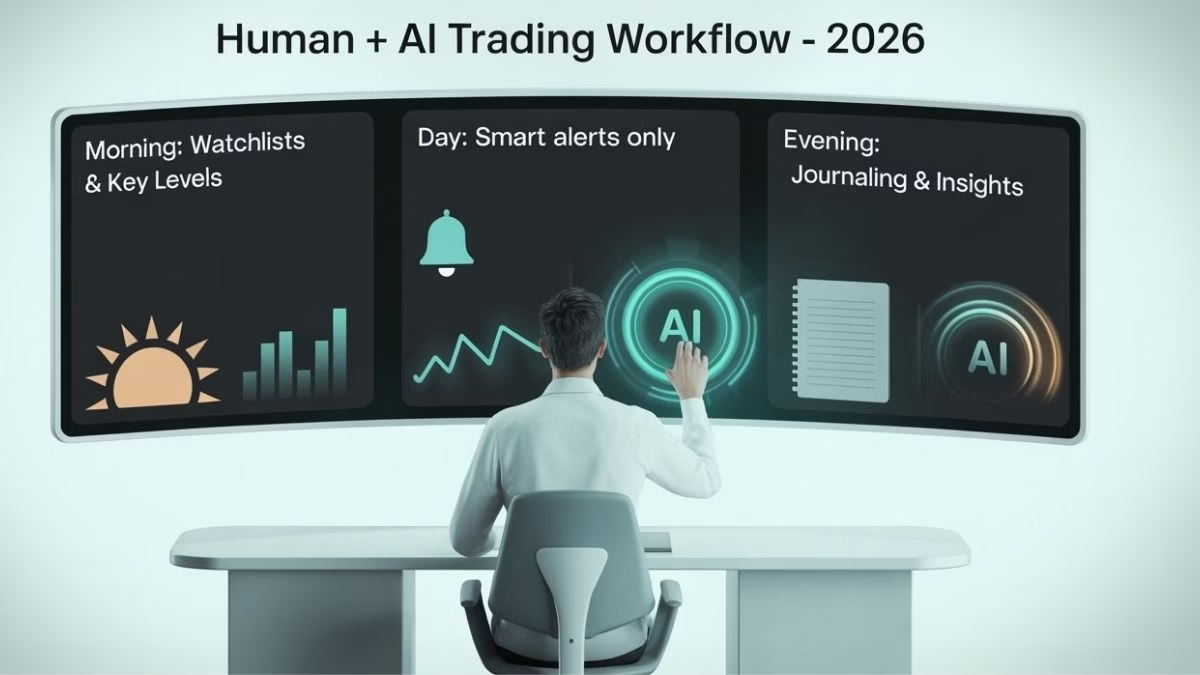
A sustainable routine matters more than any single indicator. The goal is a rhythm where AI handles scanning and measurement, while you handle objectives and final decisions. The same philosophy shows up in Master Stock Market Basics and Quantum Trading Strategies, where technology stays in a supportive role and decisions still follow clear human intent.
Designing a normal day with AI-powered trading strategies 2026 keeps things calm.
- Morning sessions might focus on overnight summaries, key levels, and AI-generated watchlists filtered by your strategy rules.
- During the trading day, alerts highlight moments when conditions match your playbook, instead of asking you to stare at every tick.
- Evening reviews include trade journaling, performance stats, and notes on how well you followed your own rules. AI can summarise patterns you might miss.
- Weekly or monthly check-ins give space to refine parameters, prune weak ideas, and gradually expand into new markets once results stay stable.
Mistakes That Derail AI Day Trading Strategies 2026
Day trading magnifies both strengths and weaknesses. AI day trading strategies 2026 face particular risks when traders over-optimise for the past, ignore transaction costs, or neglect infrastructure and regulation.
Regulatory papers and academic reviews repeatedly flag these vulnerabilities in algorithmic and high-frequency approaches.
- Overfitting makes systems look brilliant in a backtest yet fragile in live markets. Walk-forward analysis and realistic cost assumptions counter this trap.
- Excessive trading frequency adds hidden costs. Even small edges vanish once slippage and fees accumulate across many tiny trades.
- Weak monitoring leaves algorithms running in conditions they were never designed to handle. Dashboards, alerts, and clear emergency stop rules reduce this hazard.
- Emotional overrides still cause trouble. Size changes after winning or losing streaks can undo months of careful testing.
Connecting AI Trading to Wider Tech Trends
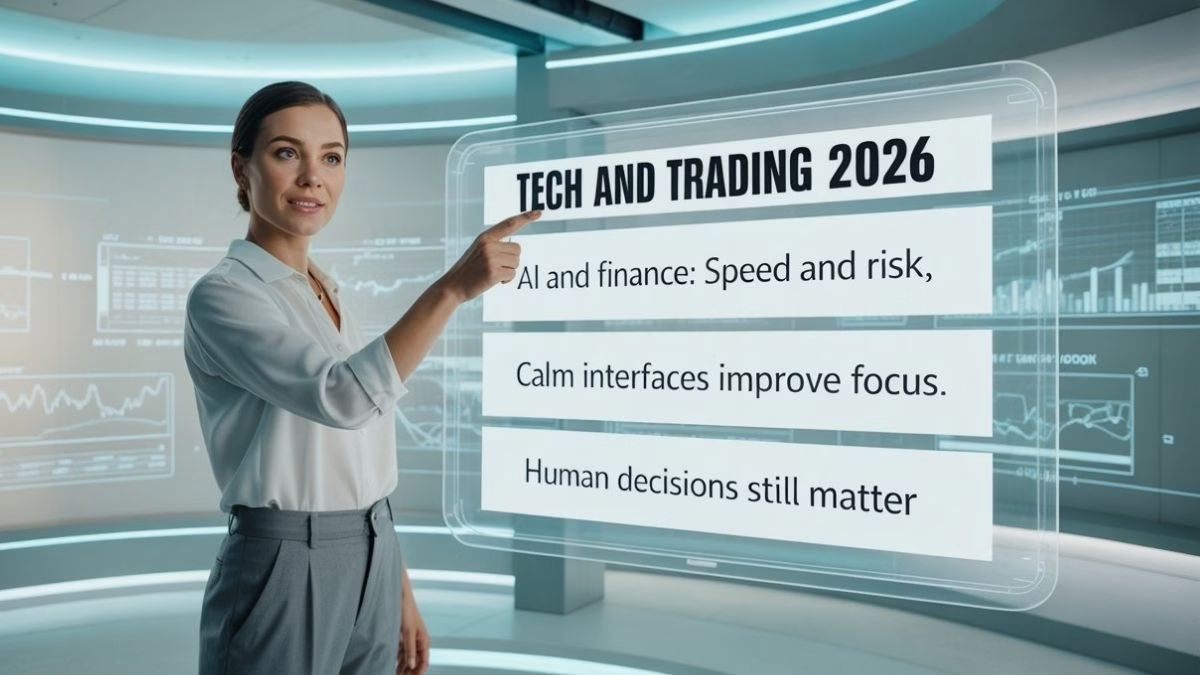
AI trading sits inside a wider wave of tools that reshape decisions across finance, design, and digital business. Future-focused content such as Liquid Web Design 2026, Smart Ring Trend 2025, and Neuromarketing Techniques Marketers Need in 2026 already shows how intelligent systems change the way people browse, shop, and respond to information. An overview from OECD – AI in finance highlights both the efficiency gains and the new systemic risks of AI-driven markets, which reinforces the need for clear rules, thoughtful oversight, and honest communication around every automated strategy.
- Interface and UX trends make complex dashboards calmer, which matters when traders manage several strategies and markets throughout the day without feeling overwhelmed.
- Automation in ecommerce, content workflows, and analytics proves that delegating repetitive work to software frees more energy for creative planning and review.
- Behavioural insight from neuromarketing and digital psychology reminds everyone that data-driven tools still interact with human emotions, habits, and attention spans.
- Rapid growth in AI usage across crypto apps, wealth platforms, and retail trading tools suggests that future market participants will treat AI as a normal part of the trading toolkit, similar to charting software or screeners today.
Conclusion: Let AI Handle the Noise, You Handle the Rules
Strong AI-powered trading strategies 2026 do not promise certainty. They offer structure. AI scans markets, measures patterns, and enforces rules, while you remain responsible for defining risk, timelines, and personal goals that feel realistic.
When tools, risk practices, and daily routines align, well-chosen AI trading tools 2026 become partners instead of mysterious black boxes. The future of trading looks less like handing everything to robots and more like calm traders working with powerful assistants that filter market noise into clear, thoughtful choices.
FAQs
Are AI-powered trading strategies suitable for complete beginners?
Beginners can use AI-powered systems safely when they start small, focus on simple rules, and set strict risk limits. Platforms that provide guided templates, demo modes, and clear education remove much of the guesswork. The key lies in treating AI as a supportive assistant rather than a shortcut to instant results. When beginners pair those tools with patient journaling and review, they learn faster without placing their full capital at risk.
What kind of returns can traders realistically expect from AI in 2026?
Returns vary widely, depending on markets, strategy quality, risk tolerance, and discipline. Some AI-supported systems may outperform benchmarks during certain periods, while others underperform or move sideways. Studies and industry reports emphasise that AI improves analysis and execution but still operates in uncertain markets. Expectations stay healthier when traders aim for consistency and manageable drawdowns instead of spectacular, unstable gains.
Do AI trading tools replace human judgment in the stock market?
AI helps by spotting patterns, testing ideas quickly, and handling repetitive tasks without fatigue. However, human judgment still matters for setting goals, choosing risk levels, and responding to unusual events or personal constraints. Leading voices in fintech repeatedly point out that technology supports decision-making rather than replacing the motivations, values, and experience behind each choice. AI becomes most useful when treated as a partner with clear boundaries.
How much capital is needed to start with AI-based strategies?
There is no universal minimum. Some traders begin with small equity or ETF accounts, while others operate larger futures or options portfolios. A practical approach starts with capital you can afford to lose, then risks only a small percentage per trade. Resources on position sizing from sources such as Investopedia and Britannica highlight how this approach helps protect accounts while traders experiment and refine strategies.
Is coding required to use AI in trading?
Coding skills help when you want full customisation or plan to work with platforms like QuantConnect. However, many modern tools provide no-code builders, drag-and-drop interfaces, or natural-language rule creators. These options let you express logic in everyday language, then let the system build the technical layer in the background. Traders can always deepen their skills later if they enjoy more technical exploration.
How does regulation affect AI and algorithmic trading for individuals?
Regulators such as ESMA in Europe and SEBI in India focus on transparency, risk controls, and market stability. Their guidance stresses robust systems, logging, throttles, and safeguards against runaway algorithms or unfair market impact. For retail traders, this usually means using platforms and brokers that already implement strong controls and provide clear information about how their systems operate.
Can AI trading bots collude or behave in harmful ways?
Academic work on machine learning in trading notes that unintended behaviours can arise when models optimise for metrics that differ from what humans truly want. In extreme cases, these behaviours could include forms of coordination or aggressive tactics that regulators view as harmful. This concern underpins much of the ongoing regulatory review. Retail traders protect themselves by favouring transparent tools, monitoring live results, and keeping ultimate control over position size and risk.
What data sources do AI strategies usually rely on?
Most strategies begin with price and volume history. Many also incorporate volatility measures, order-book data, fundamentals, macro indicators, or sentiment from news and social channels. The richer and cleaner the data, the better AI can distinguish between normal noise and meaningful patterns. Traders should pay attention to which inputs a platform uses so they understand what each signal truly reflects.
How can traders avoid overfitting when designing AI models?
Avoiding overfitting requires discipline during strategy development. Walk-forward testing, cross-validation, and realistic transaction cost assumptions help reveal whether a pattern genuinely holds up or only works in a cherry-picked sample. Industry reviews on machine learning in trading suggest limiting the number of tuned parameters and keeping strategies aligned with clear economic or behavioural logic, instead of chasing every tiny historical advantage.
Where does AI trading fit in a long-term investing plan?
AI trading can sit alongside long-term investing as a complementary activity. Some traders keep a diversified core portfolio aimed at multi-year goals, then allocate a smaller portion of capital to more active, AI-supported strategies. This structure allows experimentation and learning without tying entire financial futures to short-term swings. Over time, data from the active sleeve can inform adjustments while the core holdings continue to follow a quieter path.

